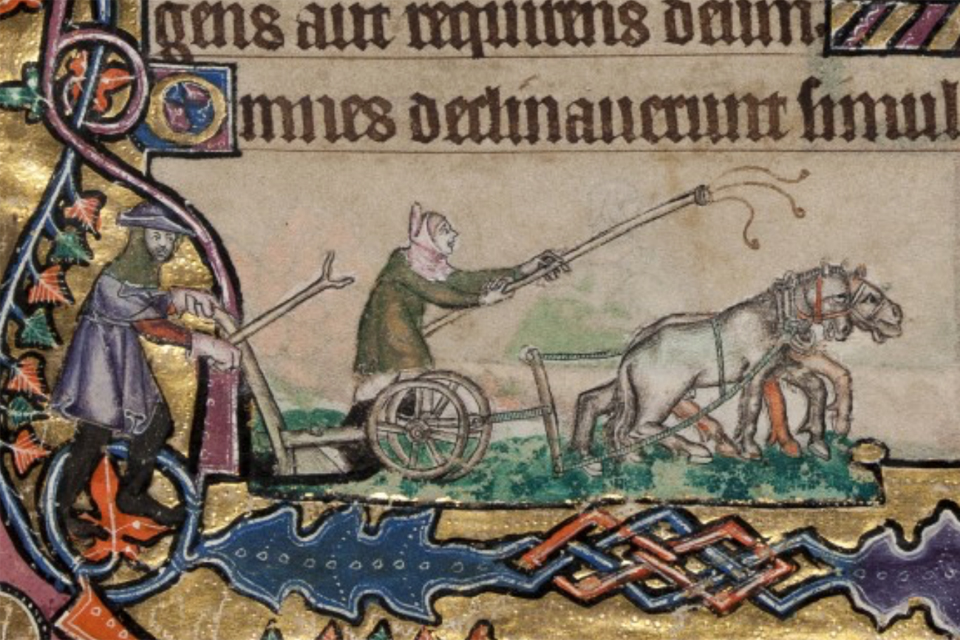For a long time technical wizards have worked to develop new – non-invasive – methods of studying our medieval manuscripts. Cutting-edge research carried out on the collections in the Fitzwilliam in Cambridge is currently exhibited.
The Three Living and the Three Dead
This exhibition celebrates the Fitzwilliam’s 2016 bicentenary with a stunning display of 150 illuminated manuscripts from its rich collections. They range from the prayerbooks of European royalty and merchants to local treasures like the Macclesfield Psalter, from an alchemical scroll and a duchess’ wedding gift to the ABC of a five-year old princess.
Manuscripts were at the heart of Viscount Fitzwilliam’s collection with which the Museum was established in 1816. Yet, many of these are displayed here for the first time. They can only be seen at the Museum due to a clause in Fitzwilliam’s bequest, which prevents them from leaving the building. This reveals the anxieties of the Founder who had assembled his treasures in the aftermath of the French Revolution.
The hundreds of images sheltered in volumes that were cherished in princely and religious libraries for centuries constitute one of the largest and best preserved repositories of medieval and Renaissance painting. With most panel and wall paintings destroyed by war, greed, puritanical zeal or time, illuminated manuscripts are the richest resources for the study of European painting between the sixth and the sixteenth century – the main focus of this exhibition. Highlights of Byzantine, Armenian, Persian and Sanskrit manuscripts are also included.
Virtual Expedition
Visitors are cordially invited to travel from eighth-century Northumbria to seventeenth-century Nepal via Oxford, Paris, Bruges, Cologne, Florence, Venice, Constantinople, Jerusalem and Kashmir. On the way it is possible to discover the secrets of the original masterpieces and modern forgeries; and find out what cutting-edge technologies reveal about their painting materials, and the images’ meaning and value to their owners.
However, since the manuscripts must never leave the building where they reside, the curators have for a long time been involved in the digitization of all the wonders.
No wonder, then, that the website provides us with ample opportunities to acquaint ourselves with not only the masterpieces up front, but the reflections of the curators behind the different themes: colours, palettes, pigment recipes and model books as well as the colour theories, philosophers and artists of that time gave thought to.
COLOUR showcases advanced research undertaken by the Fitzwilliam’s curators, scientists and conservators involved in the Cambridge Illuminations and MINIARE projects. It celebrates modern-day discoveries inspired by collections assembled over 200 years.
VISIT:
COLOUR: The Art and Science of Illuminated Manuscripts
The Fitzwilliam Museum, Galleries 12 & 13
Trumpington St, Cambridge CB2 1RB
30.07.2016 – 30.12.2016
CONFERENCE:
Manuscripts in the Making: Art and Science
08.12.2016 – 10.12.2016
Department of Chemistry, University of Cambridge
Lensfield Rd, Cambridge CB2 1EW
LEARN MORE:
Virtual visitors are cordially invited to study a number of the treasures at a dedicated site: Illuminated. Manuscripts in the Making.
CATALOGUE:
COLOUR: The Art and Science of Illuminated Manuscripts
Edited by Stella Panayotova
First published in 2016 by Harvey Miller Publishers, an Imprint of Brepols
ISBN 978-1-909400-57-3
FEATURED PHOTO:
The Macclesfield Psalter
England, East Anglia, probably Norwich, c. 1330-1340
MS 1-2005, fol 77 r
